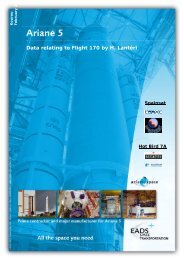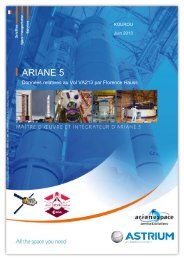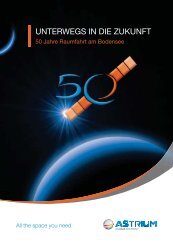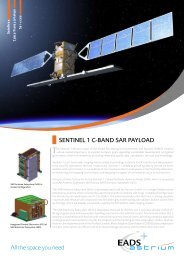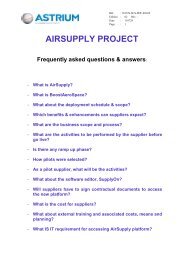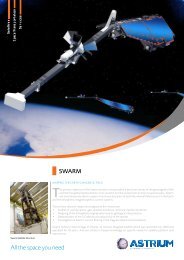Flight 207: Ariane 5 ECA/Echostar-17 - Astrium - EADS
Flight 207: Ariane 5 ECA/Echostar-17 - Astrium - EADS
Flight 207: Ariane 5 ECA/Echostar-17 - Astrium - EADS
Create successful ePaper yourself
Turn your PDF publications into a flip-book with our unique Google optimized e-Paper software.
Data relating to <strong>Flight</strong> <strong>207</strong><br />
Compared with the ARIANE 5 “generic” version of the main stage, the main changes are<br />
integration of the Vulcain 2 engine (generating 20% more thrust than the Vulcain 1), lowering of<br />
the tank common bulkhead, and strengthening of the forward skirt and thrust frame structures.<br />
As in the case of the previous A5 <strong>ECA</strong> launcher (L521) used for flight 164, the Vulcain 2 has<br />
undergone a number of changes, principally to the nozzle (shortened and strengthened) and<br />
the cooling system (dump-cooling).<br />
The tank is divided into two compartments containing <strong>17</strong>5 tons propellant (approximately 25<br />
tons liquid hydrogen and 149.5 tons liquid oxygen). The Vulcain 2 engine delivers of the order<br />
of 136 tons thrust, and is swivel-mounted (two axes) for attitude control by the GAM engine<br />
actuation unit. The main stage is ignited on the ground, so that its correct operation can be<br />
checked before authorising lift-off.<br />
The main stage burns continuously for about 539 s, and delivers the essential part of the kinetic<br />
energy required to place the payloads into orbit.<br />
The main stage also provides a launcher roll control function during the powered flight phase by<br />
means of the SCR (roll control system).<br />
On burnout at an altitude of <strong>17</strong>2 km for this mission, the stage separates from the upper<br />
composite and falls back into the Atlantic Ocean.<br />
Type-C solid propellant strap-on boosters:<br />
Each booster is over 31 m high, and has a diameter of 3 m and an empty mass of 38 tons.<br />
Each booster contains 240 tons solid propellant, and essentially comprises:<br />
• booster case assembled from seven steel rings,<br />
• steerable nozzle (pressure ratio Σ = 11), operated by a nozzle actuation unit (GAT),<br />
• propellant in the form of three segments.<br />
Equipment displayed at the Paris Air Show in 2001<br />
The boosters (EAP) are ignited 6.05 s after the Vulcain engine, i.e. 7.05 s from H0. Booster<br />
thrust varies in time (approx. 600 tons on lift-off or over 90% of total thrust, with a maximum of<br />
650 tons in flight). EAP burn time is about 135 s, after which the boosters are separated from<br />
the EPC by cutting the pyrotechnic anchor bolts, and fall back into the ocean.<br />
5




